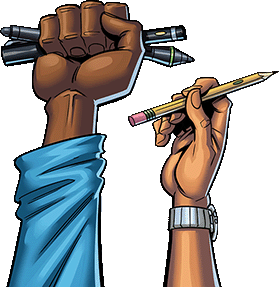Tips for Formatting a Comic Book Script
February 17, 2021
If you’re starting on the creative journey of writing a comic book, you need to have a format guide to make sure you meet industry standards.
Think of your comic book script as a blueprint from which more extraordinary things can be created. Usually, creating a comic takes different people of various skills. Letterers, colorists, editors, and others contribute to the raw creative materials that become the finished product.
The biggest expectation for a comic book script is clarity. With so many people working on one project, your artistic vision needs to be clear to all parties involved. This means you need to adhere to industry standbys of how to craft a comic book script.
Here are some tips to make sure your comic book script is crystal clear to all your collaborators.
Use a 1:1 Ratio
Use the 1:1 ratio so that each page corresponds with one page of your comic book. The panel and page need to match up to ensure that everyone understands the narrative and action occurring on each page.
If an editor looks at script page 21, it should be the same number as the comic book pages. Put the number at the top of each leaf of paper as the first text anyone sees. Underneath the page number, you can number the panels.
Formatting Dialogue
This is one of the most crucial aspects of comic script writing, as you want everyone who looks at the sample script to know exactly what is an image and what goes into a speech bubble.
The dialogue should come under a subheader that tells you what number panel you’re looking at and should be placed farther indented than any image descriptions.
Number Everything
It may seem like overkill, but number all the aspects of your script, from sound effects to speech bubbles.
Keep track of how many lines of dialogue you have. If it is over 20 for one page of your script, your artwork won’t have any room to breathe.
Write Lean Panel Descriptions
This may be one of the most challenging aspects of scriptwriting, keeping it concise. When you write a comic book script, include panel descriptions with the other elements.
Your establishing shot may be an intricate city landscape, but you don’t have to describe every building in your panel descriptions. Only provide the information that the artists, colorists, and letterers need to create the image and text you want. If you have extra information that you’d like to impart, you can use additional pages.
Use Supplemental Items
You can use your comic’s first pages to add character synopsis, descriptions of the setting, or any backstory you may need.
You may not include all of it in your final cut, but these additional pages help keep everything straight as a comics creator. Fans often love supplemental information, as well.

The Takeaway
For comic book writers, correct script formatting is crucial. If you’ve been considering expanding your comics experience to becoming not just a reader but also a writer, it pays to learn as much as you can about comic book script formatting.
At Comix Well Spring, our publishing experts can help you through this sometimes complicated yet always rewarding process. Contact us today to begin your creative journey.


